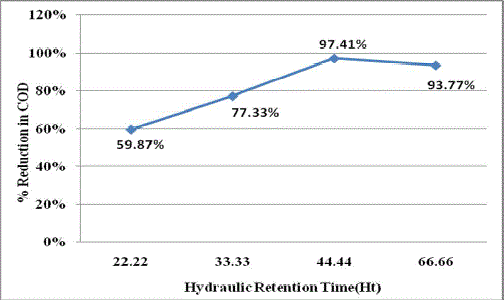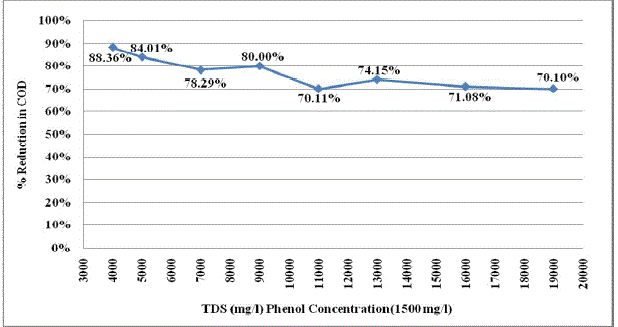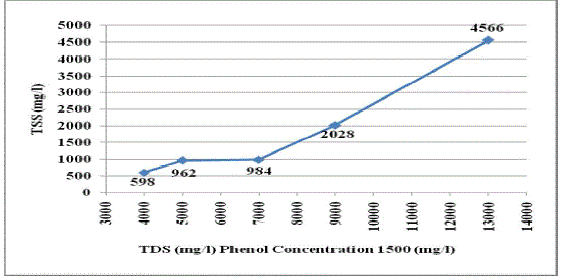ISSN ONLINE(2319-8753)PRINT(2347-6710)
ISSN ONLINE(2319-8753)PRINT(2347-6710)
Arti D. Galgale 1, Neha B. Shah 2, Dr. Nirav G. Shah3
|
| Related article at Pubmed, Scholar Google |
Visit for more related articles at International Journal of Innovative Research in Science, Engineering and Technology
Many industries generate phenolic wastewater of acidic nature. Neutralization with sodium hydroxide generates the phenolic wastewater with high TDS. Both phenol and ionic concentration of TDS are inhibitor to biological treatment processes. A study was carried out for biological treatment of phenolic wastewater with high total dissolved solid (TDS) concentration in moving bed biofilm reactor (MBBR). Three experiments were conducted in laboratory scale reactor to determine optimum hydraulic retention time (HRT) in the reactor at 1400 mg/L phenol concentration and 1500 mg/L TDS, effect of increased TDS (up to 19000 mg/L) on COD removal efficiency of the reactor and to study performance of the suspended and attached growth biomass in MBBR.
Keywords |
| Phenol, COD, TDS, MBBR |
INTRODUCTION |
| Phenol and other phenolic compounds are common constituents of many industrial effluents from chemical operations such as polymeric resin production, oil refining, pesticides, pulp and paper manufacturing etc (1). Various industries like pharmaceutical, petroleum refining, pesticide manufacturing, synthetic resin, wood pulp production and coke manufacturing are rich source of phenolic wastewater (Autenrieth et al., 1991). Many synthetic organic compounds have phenol as their basic structural unit (2). |
| Phenol is protoplasmic poison and its toxic effects are pronounced even at very low concentration. USEPA has listed phenol as priority pollutant and set a discharge limit of 0.1 mg/l of phenol in wastewaters. As per Indian Standards for disposal of treated effluents (IS: 2490 Part A), the permissible limit for phenol for the discharge of effluent into inland surface water is 1.0 mg/l and in public sewer and marine disposal it is 5 mg/L. The effect of phenol on the aquatic life is destructive at low concentrations; for fishes 5-25 mg/L is lethal depending on the temperature and state of maturity When phenol in several micrograms per liter combines with chlorine, it imparts an objectionable, medicinal taste to drinking water. Concentration as low as 0.1 mg/L leaves an odor. Phenol is third largest of the secondary product of benzene (2). Phenol should be treated prior to discharge to the receiving waters. |
| Apart from direct effects on environment, phenol is a known inhibitor of biological reactions influencing the treatment efficiency of wastewater treatment plants dealing with industrial phenolic effluents. Phenolic wastes are mostly resistant to biological degradation in wastewater treatment plants. Inhibition of the biological treatment process is encountered at a phenol concentration of 50 mg/L or higher. |
| High TDS concentration in wastewater affects efficiency of biological treatment adversely. High salt concentrations in wastewater cause plasmolysis and loss of cell activity. Total dissolved solids cause toxicity through increases in salinity, changes in the ionic composition of the water and toxicity of individual ions thereby resulting in low COD removal efficiencies (3). |
| Many industrial wastewater contain high concentration of total dissolved solids, may be resulting due to neutralization or other chemical treatment processes. The phenolated vegetable oils are new aromatic-aliphatic bio based raw materials suitable for preparation of polyurethanes, as intermediate for phenolic resins or as bio based antioxidants. These industries may serve as a source for phenolic wastewater with high TDS (4). |
| Aqueous phenolic wastes have been treated for many years by biological treatment processes such as aerobic and anaerobic systems. Aerobic treatment of industrial wastewater is a viable technology due to rapid development of high rate reactors such as biofilm reactors. Bioreactors implying biofilm systems play important roles in the detoxification of hazardous organic contaminants (1). |
| Moving Bed Biofilm Reactor (MBBR) is a highly effective biological treatment process that was developed on the basis of conventional activated sludge process and biofilter process. Researchers have proved that MBBR possesses many excellent traits such as high biomass, high COD loading, strong tolerance to loading impact and no sludge bulking problem (5). |
| Literature survey was intended to cover two aspects of the study. One is to observe efficiency of MBBR for phenolic COD removal and other to assess the effect of high TDS on COD removal efficiency of MBBR. Study conducted by B.Ayati et al (14) on degradation of aromatic compounds using Moving Bed Biofilm Reactors indicated that at low phenol and hydroquinone concentration (from 700-1000mg/l) maximum removal efficiency (over 80%) was obtained. By further increasing in COD loading rate up to 3000 mg/L, a decrease in COD removal rate was occurred. |
| Nikhitha P., Shibu K. (5) reported that the removal efficiency of phenol and COD is affected by the Hydraulic Retention Time (HRT) and the initial phenol concentration which was fed into the reactor. The maximum efficiency was obtained at 8 days for an initial phenol concentration of 400 mg/L and the same at 2 days for a lower phenol concentration of 10 mg/L. |
| Results of the study by S.H.Hosseiny and S.M.Borghei(1) indicated that the removal efficiency of phenol is affected by the hydraulic retention time and the ratio of phenolic COD concentration to total soluble COD in the reactor feed. At a ratio of 0.6, maximum COD removal efficiency is observed, and this ratio is effective at all HRT’s. The effect of hydraulic and toxic shock on the performance of the reactors were examined, and the results proved that the MBBR has good resistance to shock loads and return to steady state condition within two or three cycles of retention time. Microscopic examinations showed that the main bacteria culture attached to carrier elements and biofilms were of filamentous type. |
| C.R.Woolard and R.L.Irvine (15) conducted study with isolated moderate halophile reported an average phenol removal of over 99.5% in the Sequence Batch Reactor for simulated oil field produced water containing 15% salt with supplementation of iron, nitrogen and phosphorus. |
| Phenol degradation up to 99% was reported by Gholamreza Moussavi et al (16) by mixed culture in Aerobic granular sequence batch reactor for the feed saline wastewater at inlet phenol concentrations of up to 1000 mg/L and TDS concentrations up to 8% with total cycle time of 17 h. |
| Comparative Study of stirred tank and fluidized bed bioreactors by G. Gonzalez et al (17) for Biodegradation of phenol in continuous process indicated that both bioreactors showed high phenol degradation efficiencies, higher than 90%, even for a phenol loading rate in the influent as high as 4 g phenol/l day. The fluidized bed bioreactor showed better performance than the suspended-culture bioreactor due to its better control and because it could operate with lower HRT |
| Kargi and Dincer (1997) observed that the effluent COD removal efficiency fell from 85% to 59% when salinity increased from 0 to 5%. Thereafter, Dincer and Kargi (2001) tested innovative treatment processes in halophilic conditions including, for instance, a process with aerobic rotating discs whose number and surface area varied. This reactor was used to purify a synthetic effluent under conditions of increasing salinity (0–10%) and made it possible to exceed 80% of COD removal efficiency as long as the salt concentration remained lower than 50 g l-1 (10). |
| A study has been carried out to evaluate the effect of high phenol concentration and high TDS on COD removal efficiency of MBBR. |
| Study components include |
| ï· Determination of COD removal efficiency of MBBR for synthetic wastewater with increasing phenol concentrations and TDS. |
| ï· Determination of optimum hydraulic retention time (HRT) for desired removal of COD with given phenol and TDS concentration. |
| ï· Effect of TDS on efficiency of MBBR. |
II. MATERIALS AND METHOD |
| A flexi glass reactor of 8 liters capacity was used as MBBR in the study. Biofilm carrier (Plastic media) made of polypropylene having size 16 mm lengths & 16 mm diameter & surface area 339m2/m3 were used (6, 7, 8, 9). The filling ratio ranges from 30–70% of the total reactor volume (7). It is recommended that the filling fractions should be below 70% so as to be able to move the carriers freely (6, 9). The filling ratio (volumetric filling in empty reactor) was selected randomly as 40 % of the reactor volume. Study was carried out for continuous operation and desired flow rate was maintained with Peristaltic pump. |
| Wastewater was synthesized by adding laboratory grade phenol and Sodium sulphate in varying concentrations to have desired COD and TDS in raw wastewater. |
| Biomass over plastic media was developed by aerating new media along with mixed liquor and raw sewage from existing sewage treatment plant. Media was observed under the microscope for biomass development. Time duration required for development of biomass on plastic media was about 25 days (8). |
Acclimatization of Biomass with Phenol |
| The biomass on plastic media was then acclimatized with phenol in MBBR initially as batch reactor and then in continuous flow reactor. Biomass acclimatization was done by gradually increasing phenol concentration from 100mg/L to 800 mg/L in the increment of 100 mg/L. COD was taken as evaluating parameter as 1mg/L phenol contribute 2.3 mg/L COD. Dissolved Oxygen in the reactor was maintained as 1-3 mg/L (9). pH in the rector was measured around 8. In aerobic process ratio of BOD:N:P was maintained as 100:5:1 following Eckenfelder’s biodegradation criteria. To avoid the nutrient deficiency Urea & KH2PO4 (Potassium di-hydrogen orthophosphate) were added in the reactor (7). Beyond 800 mg/L phenol concentration, reactor was operated as continuous flow reactor to prevent shock loading of phenol on biomass in batch process. |
Biodegradation of Phenolic Wastewater with Increasing Phenol and TDS |
| Continuous flow reactor was operated with increasing phenol concentration from 1000 mg/L to 1500 mg/L and increasing TDS (from 1000 mg/L to 22000 mg/L). |
| After proper acclimatization of microorganisms with phenol concentration of 1400 mg/L and TDS of 1500 mg/L, HRT corresponding to maximum % removal of COD was determined (Figure 1) (5). HRT was varied by varying influent flow rate with peristaltic pump. |
| At optimum HRT of 44 hrs, TDS concentration in the reactor was increased gradually from 3000 mg/L to 19000 mg/L and finally to 22000 mg/L with sodium sulphate (Na2SO4). COD concentration in the influent was controlled by keeping phenol concentration at 1500 mg/L |
| The effect of increasing TDS (phenol concentration of 1500 mg/L and HRT 44 hrs) on efficiency of COD removal was observed (Figure 2). |
| Table1 presents COD removal efficiency of MBBR at varying organic loading rates at 1500 mg/L phenol concentration with 22000 TDS. Ratio of MLVSS in suspension to VSS on plastic media was calculated for different HRT. To demonstrate the biomass concentration attached to media, a known numbers of carriers were taken out of the reactor and completely washed with measured amount of distill water, the liquid so obtained is subjected to VSS determination. As the number of carriers was known in the MBBR the total attached biomass in the reactor could be calculated (13). |
III. RESULTS & DISCUSSION |
| Figure 1 shows optimization of HRT at phenol concentration of 1400 mg/L. Reactor was operated at this optimum HRT for further study with increased TDS concentration. |
 |
| Maximum % COD reduction of 97.44% was obtained at HRT of 44 hrs (3ml/min influent flow rate) (6). Further increase in HRT did not cause any increase in % COD reduction. |
| Figure 2 shows effect of varying concentrations of TDS from 4000 mg/L to 19000 mg/L with 1500 mg/L phenol concentration at 44 hr HRT on COD removal efficiency. |
 |
| As TDS was increased from 4000 mg/L to 19000 mg/L percentage reduction in COD decreased from 88.36% to 70.10%. Increase in salt concentration tends to disrupt normal metabolic function & reduce degradation kinetic of the system. Effect of increased TDS was also observed on effluent suspended solid concentration with increase in TDS concentration in influent wastewater increase in effluent suspended solid concentration was observed (Figure 3). For effluent, VSS concentration also found to be increasing (Figure 4). Past studies of saline wastewater treatment indicate the adverse effect of high salinity on conventional biological treatment processes (10). This can be attributed to high osmotic stress on inhibition of the reaction pathways in the inorganic degradation processes (11). In addition, high salt content induces cell lysis (10) which increases effluent solids. The population of protozoa for proper flocculation is also significantly reduced at high salt content, (10, 12) resulting in low sedimentation efficiency. |
 |
 |
| The ratio of MLVSS in suspension to VSS on plastic media as per Table 1 for phenol concentration 1500 mg/L with 22000 TDS shows that the concentration of attached growth biomass improved gradually and the suspended growth biomass concentration decline stepwise. With increase in HRT the ratio of MLVSS in suspension to VSS on media gradually decreased & biomass on attached media increased. With decrease the ratio, % COD reduction increased. This indicates that attached biomass is largely responsible for organic removal in reactor. |
IV. CONCLUSION |
| An aerobic MBBR can be used to remove phenol from high TDS wastewater. The effect of attached growth biomass on pollutant removal was much better than suspended growth biomass in MBBR. |
References |
|